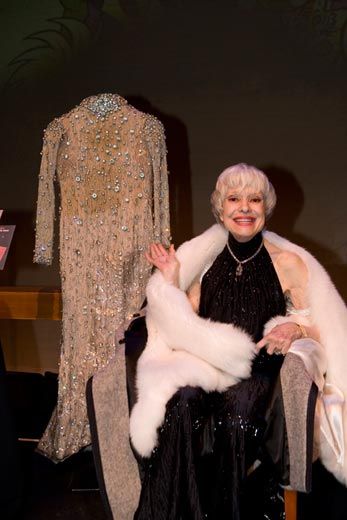All That Glitters
Carol Channing can’t forget the night her gown got ransomed
/https://tf-cmsv2-smithsonianmag-media.s3.amazonaws.com/filer/channing_aug08_631.jpg)
When broadway star Carol Channing sang "Diamonds Are a Girl's Best Friend" in the 1974 musical Lorelei, all that glittered was not what it seemed. Designer Bob Mackie created the show's eye-catching costumes, including a bejeweled dress for the character Lorelei Lee's big number. (Channing had gotten her big break in the Anita Loos play Gentlemen Prefer Blondes in 1949 and starred in its revival, Lorelei, 25 years later.) One of Mackie's nicknames is the Rajah of Rhinestones: what sparkled so plentifully on the gown were no more diamonds than a stage set for Hamlet could be said to be Elsinore Castle.
The showstopper of a dress, which Channing wore for all of the production's 320 Broadway performances, now resides within the collections of the Smithsonian's National Museum of American History (NMAH). Mackie's extravaganza, with its hailstorm of stones from Czechoslovakia, weighs about 40 pounds. "The first time I took a bow in that dress," Channing told me recently, "I fell over forward and almost broke my teeth." During the production, Channing had to make a quick change between scenes. "I told Bob that getting out of that dress in one minute was almost impossible. So he said, ‘Take off the sleeves.'" (Channing would wear the costume in both configurations.)
But it wasn't until late 2007 that the dress took on a life of its own. Channing was scheduled to donate the gown to NMAH at a January 2008 ceremony in North Hollywood. The event would honor distinguished women, showbiz luminaries all, who had offered items to NMAH. Angela Lansbury, for example, contributed her typewriter from television's "Murder, She Wrote." Tippi Hedren donated her script from Alfred Hitchcock's The Birds. And Julie Newmar, of the TV series "Batman," turned over her slinky Catwoman costume.
Channing's plan, however, was nearly derailed. In September 2007, as preparations were finalized, Channing was in Los Angeles, where the dress was to be appraised. When she and her husband, real estate entrepreneur Harry Kullijian, arrived at the Renaissance Hotel, a suitcase containing the dress was placed on a luggage carrier. When the valises didn't arrive at the room, Kullijian went down to the lobby and spotted the carrier: the dress was missing. "I let out a war whoop you wouldn't believe," Kullijian recalls.
The Los Angeles police were notified. Not long afterward, a man called Channing's room, demanding a ransom of $25,000 for the dress. No deal, Harry said. The next day, a stranger appeared at the hotel, claiming that he had found the costume in a city park. "I thought this guy was a hero," Kullijian says, "and went to the front desk to get some money to reward him."
At that point, Channing recalls, the situation began to deteriorate: "The man kept poking me in the chest and asking for money." When the police arrived, they immediately recognized Kullijian's "hero" as someone with a long arrest record. The alleged thief was taken into custody but no charges were brought for lack of evidence.
One question that has not been answered is how he (or whoever did it) happened to nab the dress in the first place. Channing's longtime agent, Harlan Boll, believes he has the answer. At the time Channing checked into the hotel, Boll recalls, a bellhop had inquired why one of her suitcases was so heavy. Channing replied, "Because the diamond dress is in there." That offhand remark, Boll thinks, could very well have set everything in motion. The thief may simply have overheard—and drawn a wrong conclusion. (It would, of course, turn out that rhinestones were not a guy's best friend.)
Channing describes the strange escapade as the tale of the "lost-and-found dress." Ultimately, during a gala ceremony at North Hollywood's landmark El Portal Theatre on the night of January 28, Channing was able to turn the dress over to the Smithsonian—right on schedule.
Owen Edwards is a freelance writer and author of the book Elegant Solutions.

/https://tf-cmsv2-smithsonianmag-media.s3.amazonaws.com/accounts/headshot/Owen-Edwards-240.jpg)
/https://tf-cmsv2-smithsonianmag-media.s3.amazonaws.com/accounts/headshot/Owen-Edwards-240.jpg)